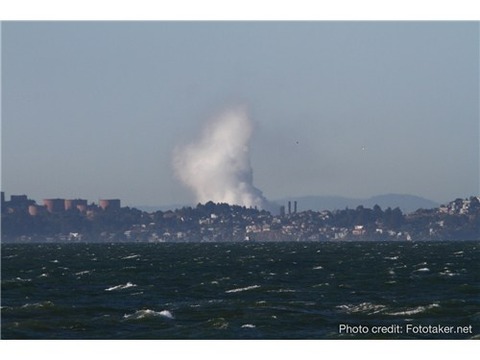Pipeline corrosion caused Chevron fire
22 Apr 2013

Washington, DC - The US Chemical Safety Board (CSB) has confirmed that severe pipeline corrosion was a root cause of a major process fire at a Chevron refinery in Richmond, California.
The refinery experienced a huge fire on 6 Aug, 2012, after crude unit distillation tower piping failed catastrophically due to sulphidation corrosion and severe pipe thinning.
A new metallurgical analysis of crude unit pipe samples from Chevron refineries in Richmond and in El Segundo, California found that the same sulphidation corrosion process had occurred in both.
The effect was causing up to 60% wall loss in a pipe sample from the El Segundo Refinery, according to a report issued by the CSB and the California Division of Occupational Safety and Health (Cal/OSHA).
The piping sample from the Chevron El Segundo Refinery, immediately west of Los Angeles, had lost up to 60% of its wall thickness, from 0.322 inches to 0.12 inches in the thinnest part.
Following its investigation, Cal/OSHA issued 25 citations to Chevron alleging serious and wilful violations of the process safety standard.
The new report was completed by Anamet, Inc., an independent materials engineering and laboratory testing company.
After the fire in Richmond, Chevron voluntarily inspected and upgraded corresponding sections of piping from El Segundo, which has a nearly identical crude unit.
No release or incident occurred in El Segundo, and Chevron has since replaced the corroded piping with an upgraded metallurgy that is more resistant to sulphidation corrosion, the CSB noted.
Both refineries processed similar crude oil, leading to sulphidation corrosion in the carbon steel piping used in both facilities, and that silicon content - which aids in corrosion resistance - was low in both cases, the report said.
Older carbon steel piping, which is common in refineries, can have widely varying levels of protective silicon, a trace constituent that is hard to measure under field conditions.
The metallurgical report confirms the consequences of running high-sulphur crude through low-silicon carbon steel piping over a period of years without using inherently safer materials of construction, according to CSB chairperson Rafael Moure-Eraso.
“The tests underscore the importance of new actions to eliminate this hazard through requiring inherently safer designs and materials, rather than relying on inspections alone to find developing safety problems,” Moure-Eraso commented.

